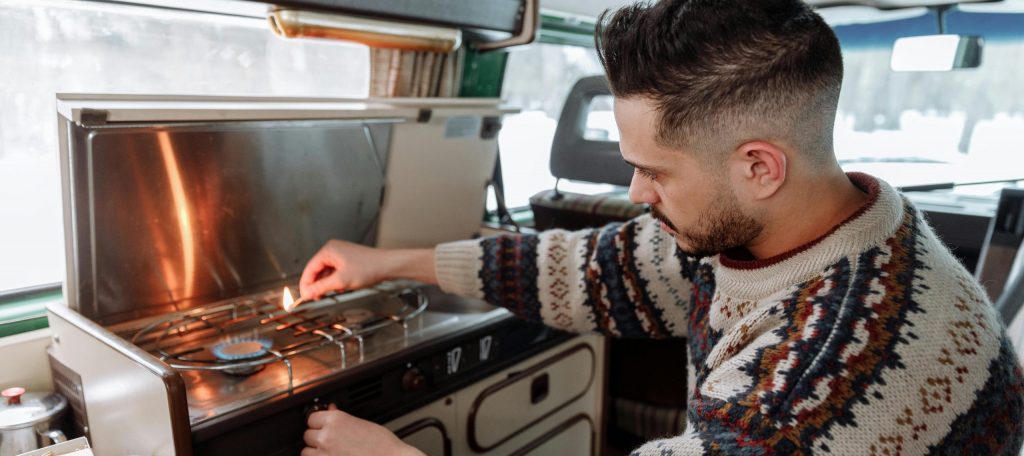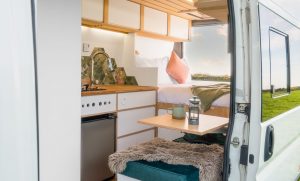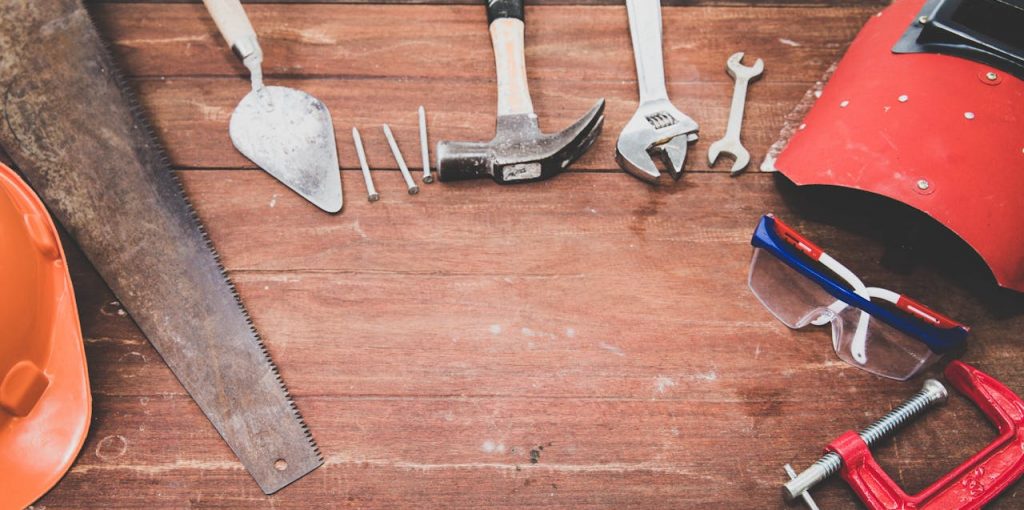Whether you’re a van lifer, holidaymaker or off-grid camper, you need food to fuel you for your adventures.
You need to make sure you choose the option that best suits you – some people love the accomplishment of creating a fresh, tasty meal on the road, whereas others prefer to spend their time doing other things.
In this campervan conversion kitchen guide, we look at whether a kitchen is necessary for your conversion, different kitchen layouts, kitchen safety and whether you should use a professional or install a kitchen yourself.
Do I need a kitchen in my campervan conversion?

It depends on your personal preferences, travel style, and the duration of your trips. Here are some factors to consider:
Trip duration
For short trips or weekend getaways, you might be able to use pre-packaged or easy-to-prepare meals that don’t need a dedicated kitchen setup. In such cases, a simple portable stove or no cooking facilities may suffice.
Do you enjoy cooking?
If you enjoy cooking and want the flexibility to prepare your meals, having a campervan kitchen becomes more important. It allows you to have control over your diet and can save you money compared to eating out. It’s also healthier than eating pre-packaged foods.
Convenience
Having a kitchen in your campervan provides convenience, especially in remote areas where access to restaurants or supermarkets is limited. You won’t have to rely on finding suitable food options while on the road. However, some people think it’s more convenient to pick up food on the go, so it’s up to you.
Cost considerations
Eating out can add up expenses during a road trip. A campervan kitchen can help you save money by allowing you to prepare your meals using more budget-friendly ingredients. However, there is a cost to set up your kitchen, so it’s worth considering whether you will use it.
Self-sufficiency
A campervan kitchen enhances your self-sufficiency, allowing you to be more independent during your travels. A kitchen is valuable if you enjoy off-the-grid camping or exploring less populated areas. If you tend to stick to semi-rural or urban areas self-sufficiency isn’t as crucial.
Space constraints
Consider the size of your campervan and how much space you’re willing to spend on a kitchen. You might opt for a more compact kitchen setup or rely on alternative cooking methods like portable stoves or grills if space is limited.
Health and dietary restrictions
If you have specific dietary requirements or restrictions, having a campervan kitchen allows you to have better control over your meals, ensuring they align with your health goals or dietary needs.
Comfort and enjoyment
For many, the ability to cook and enjoy a home-cooked meal in the comfort of their campervan adds to the enjoyment of the travel experience. It can create a cosy and personalised space.
Ultimately, deciding to include a kitchen in your campervan depends on your preferences, lifestyle, and how you envision your travel experience. Some campervan owners may choose a minimalistic approach, while others prioritise the convenience and comfort of a fully-equipped kitchen.
What layout should I pick for my campervan kitchen?
Designing an efficient and practical campervan kitchen layout involves maximising the available space while ensuring functionality and ease of use. Here are some considerations and ideas for a campervan kitchen layout:
1. Galley kitchen
A galley-style layout, with kitchen components along one side of the campervan, is a common and space-efficient design. It provides a linear workspace with storage above and below.

2. L-shaped kitchen
Create an L-shaped kitchen layout with the countertop extending along two adjacent walls. This design can offer more counter space and storage options.
3. U-shaped kitchen
A U-shaped kitchen layout for larger campervans can provide ample counter space and storage. It allows for a more spacious and organised cooking area. However, it isn’t a common layout as campervans already have limited space.
4. Pull-out kitchen
Ideal for outdoor cooking, a pull-out kitchen accessible from outside the campervan. It can include a slide-out stove, sink, and storage compartments, allowing you to cook outdoors.
5. Convertible kitchen-dining area
This layout involves a multi-functional space that can serve as a kitchen and a dining area. Foldable tables and convertible furniture allow you to transition between cooking and dining.
6. Centre island kitchen:
A centre island layout features a standalone countertop or kitchen island in the middle of the campervan. This design provides extra workspace and can serve as a focal point in the kitchen.
7. Compact kitchen pod
Some campervans use a modular kitchen pod, a self-contained unit that is easy to install and remove. These pods often include a compact sink, stove, and storage, providing flexibility in campervan design.
8. Slide-out kitchenette
Like a pull-out kitchen, a slide-out kitchenette extends a part of the campervan’s interior to reveal an equipped kitchen. This design helps maximise interior space when parked.
9. Bed-to-kitchen conversion:
In some campervans, you can convert the bed area into a kitchen by using a foldable or convertible design. This allows for a dual-purpose use of space.
10. Rear kitchen:
Placing the kitchen at the rear of the campervan is another option. This layout can provide easy access to the kitchen when the rear doors are open, creating an indoor-outdoor cooking experience.
11. Front kitchen:
In certain campervans, the kitchen is at the front near the driver’s area. This design may be suitable for those who prefer the kitchen closer to the entrance.
12. Compact kitchen with built-in storage:
A small, compact kitchen layout with built-in storage solutions, such as hidden compartments and foldable elements, helps maintain a clutter-free and organised space.
When choosing a campervan kitchen layout, consider your cooking habits, the number of people using the space, and the design of your campervan. Customisation based on your specific needs and preferences is key to creating a functional and enjoyable kitchen space in your campervan.
How to build a safe kitchen

Ensuring safety in your campervan kitchen is crucial to prevent accidents and create a secure environment, especially when dealing with cooking appliances and potential fire hazards. Here are some safety tips for a campervan kitchen:
Fire safety:
- Install a fire extinguisher in an easy-to-access location and ensure you check and service it regularly.
- Use flame-resistant materials for your campervan’s interior.
- Keep a safe distance between cooking appliances and combustible materials.
Ventilation:
- Install proper ventilation to minimise the risk of carbon monoxide buildup, especially if using a gas stove. Ventilation can also help remove cooking odours.
- Be cautious when cooking inside the campervan, and ensure adequate airflow.
Gas safety:
- If using a gas stove or other gas appliances, ensure the gas system is professionally installed and checked for leaks regularly.
- Turn off the gas supply when not using the appliances.
Electrical safety:
- If using electrical appliances, ensure the campervan’s electrical system is professionally installed and complies with safety standards.
- Regularly inspect and maintain electrical components to avoid the risk of short circuits or electrical fires.
Secure appliances:
- Secure appliances during travel to stop them from falling or causing damage.
- Ensure that any portable cooking devices are stable and placed on a flat surface.
Cook with caution:
- Be cautious when cooking with hot surfaces and open flames.
- Use pot holders, oven mitts, and other protective gear to avoid burns.
Proper storage:
- Secure all items in cabinets and storage areas to prevent them from falling during travel.
- Store sharp objects safely to avoid injuries.
Water safety:
- If your campervan has a water system, check for leaks regularly.
- Secure water containers and ensure you seal them to prevent spills.
Emergency exit:
- Know the location of emergency exits and practice evacuation procedures.
- Keep pathways clear to facilitate a quick exit in case of an emergency.
Regular maintenance:
- Conduct regular maintenance checks on all kitchen appliances, gas systems, and electrical components.
- Address any issues promptly to prevent safety hazards.
First aid kit:
- Keep a well-equipped first aid kit in your campervan, including items like bandages, antiseptic wipes, and burn ointment.
Carbon monoxide detector:
- Install a carbon monoxide detector in the campervan, especially if you use gas appliances.
Follow the manufacturer’s instructions:
- Adhere to the manufacturer’s guidelines and instructions for all appliances and equipment in your campervan kitchen.
Prioritising safety and taking necessary precautions means you can enjoy a secure and comfortable campervan kitchen experience. Regular inspections and responsible use of equipment are crucial to maintaining a safe environment on the road.
Blog: How to keep your campervan safe
Should I build a campervan kitchen myself or use a professional?
Whether you build a campervan kitchen or hire a professional depends on various factors, including your skills, time, budget, and desired outcome. Here are some considerations to help you make a decision:
Skills and experience:
- DIY skills: If you have experience with carpentry, electrical work, and plumbing, you may feel confident in building a campervan kitchen yourself. DIY projects can be rewarding and cost-effective if you have the necessary skills.
- Lack of skills: If you lack the required skills, especially in areas like electrical wiring or plumbing, hiring a professional may be a safer option to ensure a functional and safe campervan kitchen.
Time commitment:
- DIY time: Building a campervan kitchen can be time-consuming. Consider whether you have the time to dedicate to the project, including planning, sourcing materials, and completing the construction.
- Professional time: Hiring a professional may save you time, as they will have the expertise and tools to do the job efficiently. You can still contribute to the planning and decision-making process.
Budget:
- DIY cost: Building your campervan kitchen can be more budget-friendly, especially if you can repurpose materials or find affordable options for fixtures and appliances.
- Professional cost: Hiring a professional will likely incur labour costs, but you may benefit from their expertise in choosing quality materials and ensuring a well-executed design.
Design and customisation:
- DIY customisation: Building it yourself allows for greater customisation. You can tailor the design to fit your specific needs and preferences.
- Professional design: Hiring a professional may result in a more polished campervan kitchen. Professionals can provide insights and ideas based on their experience.
Safety and regulations:
- DIY safety: If you build the kitchen yourself, ensure your work complies with DVLA safety standards and regulations, especially in specialist areas like gas and electrical installations.
- Professional compliance: Hiring a professional can provide peace of mind as they should be familiar with safety regulations and ensure that the campervan kitchen meets the necessary standards.
Resale value:
- DIY impact: A campervan interior built by a professional may enhance the resale value compared to a DIY project, especially if the work is well-documented and meets industry standards.
Blog: Campervan conversion specialist vs DIY conversion: which one should you choose?

